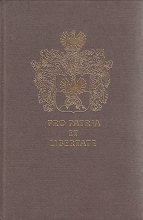
KOMJATHY : A thousand years of the Hungarian art of war (előszó)
Preface
by
General Mark Wayne Clark, United States Army (Retired)
On May 11, 1779, the Colonel Commandant of the Pulaski Legion, Michael de Kováts, a former Hungarian army officer fell on a battlefield while fighting for American independence. Two hundred and fifty years later, in commemoration of his services and supreme sacrifice, our generation unveiled his statue at The Citadel in Charleston.
I was happy to be the principal speaker on this occasion and to be able to pay tribute not only to the memory of Colonel Kováts, but also to other hundreds and hundreds of less well known Hungarians who fought for the greatest ideals of mankind.
I learned about Hungary and the Hungarians through my readings of their military history. A study of a nation's art of war, paradoxically, may be the best instrument to promote international understanding and peace. If we know the dreams and hopes of other nations, the causes of wars and their goals, we can understand better their way of thinking, the influence of past experiences on their view of life, and their national character. Knowing the qualities of nations enables us to make an educated guess as to how they will act in future crises.
While the Western World often regarded Hungary as an exotic, small country in East-Central Europe, the Hungarians proudly professed to be full-fledged members of Western civilization and culture. Neither the Mongols, nor the Ottoman Turks could convince the Hungarians to turn against the Western World.
It was not an accident, or a coincidence of circumstances that the Hungarian immigrants fought in the American Revolutionary War for independence and freedom, many of them becoming the heroes of the United States, as well as of Hungary. It was not an accident that the Hungarian immigrants volunteered and valiantly fought in proportionally great numbers in the American Civil War in the Union army but not in the Confederate army. They knew from their own history and experiences, from their memories of the Rákóczi rebellion and of the 1848 revolution, that freedom was worth fighting for anywhere in the world.
During World War II, when Stalin impatiently urged President Roosevelt and Prime Minister Churchill to establish a second front in Europe, I hoped that the Western Allies would invade the Balkans, then attack through Hungary and Poland the rear of the German eastern front. Convinced that history is the best adviser, I was sure that although the Hungarians fought bitterly against the Soviet armies, they would not deny their past, traditions and national character: if the troops of the Western Allies would reach Hungary, the Hungarians would not fight against us. Instead, they would turn against the nazi war-machine, they would award their loyalty to us and would fight on our side, as faithful comrades-in-arms for the liberation of their fatherland. Regretfully the Allied decision launching the invasion in Normandy deprived Hungary of its willingness to fight for her own freedom.
The above examples and the 1956 Hungarian revolution and fight for freedom prove that the present values of the Hungarians continue to follow the trend of their long history and valiant tradition.
This study, besides offering interesting and useful lessons of the Hungarian art of war for the professional soldier, also provides an opportunity for the general public to understand better the mentality and spirit of our fellow American and Canadian citizens of Hungarian ethnic origin. They as well as the Hungarian people are our natural allies, our comrades-in-arms, who always considered, as we did, the greatest gift of life to be freedom, worth living and fighting for.
Mark Wayne Clark
General, USA, Ret.
Charleston, June 30, 1981